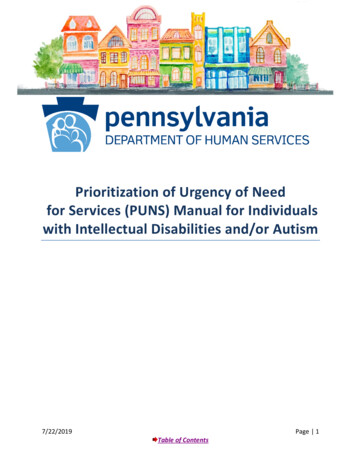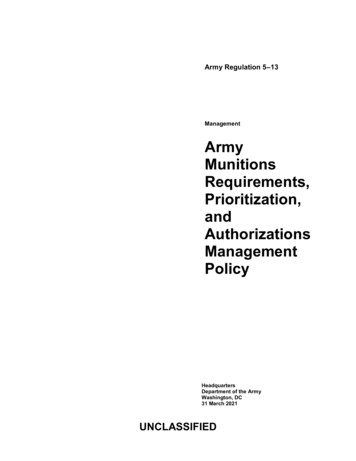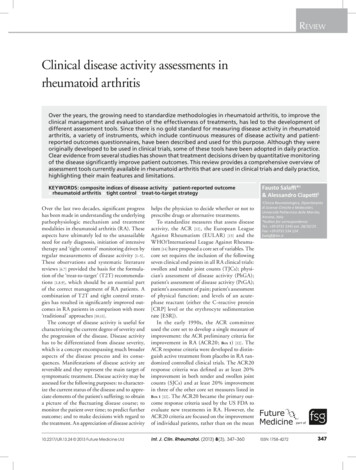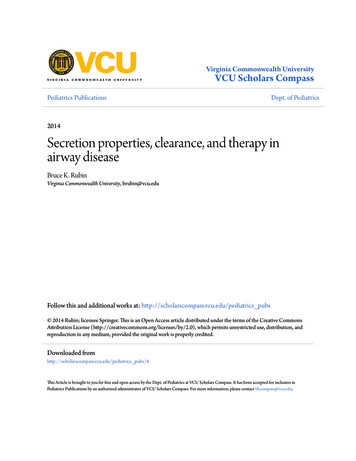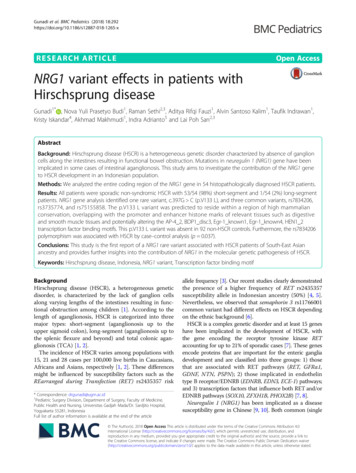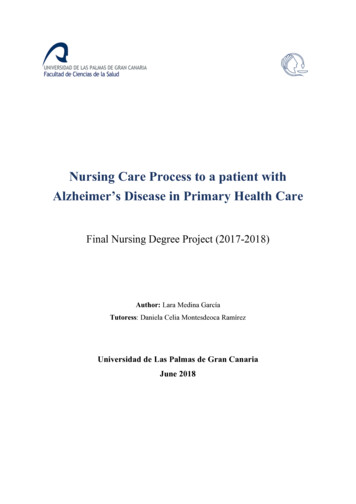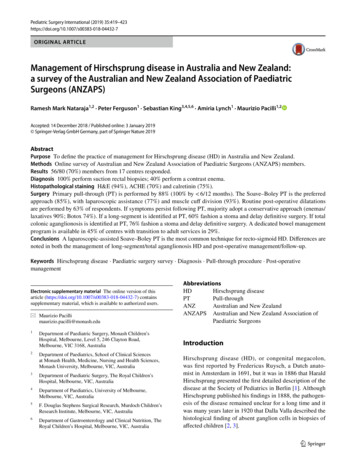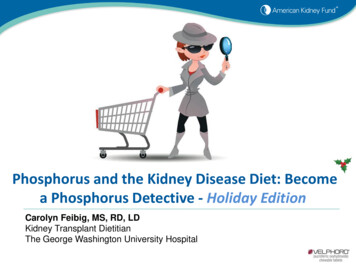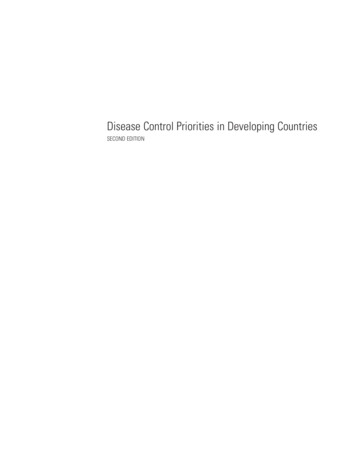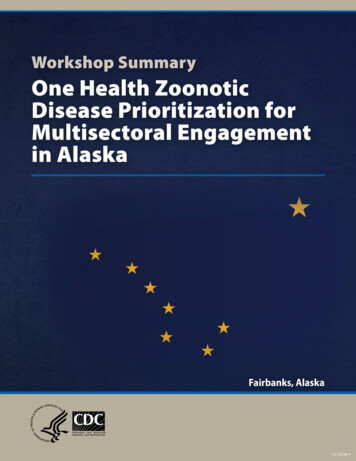
Transcription
Workshop SummaryOne Health ZoonoticDisease Prioritization forMultisectoral Engagementin AlaskaFairbanks, AlaskaCS 323380-A
O N E H E A LT H ZO O N OTIC D ISE ASE PRIO RIT IZ ATION F OR M U LTISEC TOR A L ENGAGEM ENT IN A L A SK APhoto 1. Aurora borealis (Northern Lights) displays over Endicott Mountains in Alaska.DISCLAIMERThe findings and conclusions in this report are those of the authors and do not necessarily represent theofficial position of the Centers for Disease Control and Prevention.iiFA IR B A NKS, ALASK A
ON E H E A LT H ZO O NOT IC D ISE ASE PRIO RITIZ ATION F OR M U LTISEC TOR A L ENGAGEM ENT IN A L A SK ATABLE OF CONTENTSParticipating Organizations . 1Summary . 3Table 1. Priority zoonotic diseases selected in Alaska by participants inthe One Health Zoonotic Disease Prioritization workshop conducted March 20-21, 2019. . 4Introduction . 8Workshop Methods . 9Criteria and Questions Developed . 10Priority Zoonotic Disease List for Alaska . 10Next Steps and Action Plans . 11Multisectoral, One Health Collaboration . 11Surveillance . 12Laboratory . 12Preparedness and Outbreak Response . 12Workforce . 13Appendix A: Overview of the One Health Zoonotic Disease Prioritization Process . 15Appendix B: One Health Zoonotic Disease Prioritization Workshop Participants for Alaska. 16Appendix C: Initial Zoonotic Disease List of the One Health Zoonotic PrioritizationProcess in Alaska. 18Appendix D: Criteria and questions developed for ranking the zoonotic diseases . 20Appendix E: Ranked Zoonotic Disease List of the One Health Zoonotic PrioritizationProcess in Alaska. 22Appendix F: Scores for Each Criterion of the One Health Zoonotic PrioritizationProcess in Alaska. 24References . 26FA IR B A N K S, A LA S K Aiii
O N E H E A LT H ZO O N OTIC D ISE ASE PRIO RIT IZ ATION F OR M U LTISEC TOR A L ENGAGEM ENT IN A L A SK APhoto 2. Group of Dall sheep (Ovis dali) rams on Marmot Rock at Denali National Park.ivFA IR B A NKS, ALASK A
ON E H E A LT H ZO O NOT IC D ISE ASE PRIO RITIZ ATION F OR M U LTISEC TOR A L ENGAGEM ENT IN A L A SK APARTICIPATING ORGANIZATIONS Alaska Department of EnvironmentalConservation Alaska Department of Fish and Game Alaska Department of Health and Social Services, Alaska Section of EpidemiologyAlaska Native Tribal Health Consortium,Department of Community, Environment andHealthAlaska State Virology LaboratoryAleutian Pribilof Islands AssociationNational Oceanic and AtmosphericAdministration (NOAA)North Slope Borough Department of WildlifeManagement United States Arctic Research Commission United States Centers for Disease Control andPrevention (CDC)h Arctic Investigations Programh One Health Office United States Department of Agriculture (USDA) United States Department of the Interior (DOI)h U.S. Fish and Wildlife Serviceh U.S. Geological Surveyh U.S. National Park Service University of Alaska, AnchoragePhoto 3. Woman holds wild-caught silver salmon (Oncorhynchus kisutch) from Alaska’s Kanektok River.FA IR B A N K S, A LA S K A1
O N E H E A LT H ZO O N OTIC D ISE ASE PRIO RIT IZ ATION F OR M U LTISEC TOR A L ENGAGEM ENT IN A L A SK APhoto 4. Group of brown bear fish for salmon at McNeil River Game Sanctuary.2FA IR B A NKS, ALASK A
ON E H E A LT H ZO O NOT IC D ISE ASE PRIO RITIZ ATION F OR M U LTISEC TOR A L ENGAGEM ENT IN A L A SK ASUMMARYThe purpose of the One Health Zoonotic DiseasePrioritization workshop for Alaska was to prioritizezoonotic diseases of greatest concern for Alaskausing a multisectoral, One Health approachwith input from representatives fromIndigenous, public, animal (livestock andwildlife), and environmental healthsectors and other relevant partners.This workshop was the first One HealthZoonotic Disease Prioritization Workshopconducted for a single state in the UnitedStates and the first in the Arctic region.The specific workshop goal was touse a multisectoral, One Healthapproach to prioritize endemicand emerging zoonotic diseases of greatest concern in Alaska to be jointly addressed by sectorsresponsible for human, animal, and environmental health.During the workshop, participants worked collaboratively to develop a list of zoonotic diseases forprioritization for Alaska, define criteria for prioritization, and determine questions and weights relevantto each criterion. A total of 7 zoonotic diseases were identified as a priority by participants using theOne Health Zoonotic Disease Prioritization Process, a mixed methods prioritization process, which wasdeveloped by the U.S. Centers for Disease Control and Prevention (CDC) (Appendix A).After the identification of the priority zoonotic diseases, participants developed next steps and action plansto address the priority zoonotic diseases in collaboration with One Health partners.The priority zoonotic diseases for multisectoral, One Health collaboration for Alaska are (Table 1): Amnesic shellfish poisoning/paralytic shellfish poisoning* Zoonotic influenza Rabies Cryptosporidiosis/giardiasis Toxoplasmosis Brucellosis Q fever*Amnesic shellfish poisoning (ASP) and paralytic shellfish poisoning (PSP) are not zoonotic diseases but given theconcerns and rising prevalence of algal toxins in the environment of Alaska, they were added to the list. Becausethe ASP and PSP toxins originate in microbes and are transmitted through the food chain, they represent a OneHealth concern with similar properties to zoonotic infections.This report summarizes the One Health Zoonotic Disease Prioritization Process used to prioritize zoonoticdiseases of greatest concern for Alaska, as well as next steps and action plans identified to jointly addressthese zoonotic diseases using a multisectoral, One Health approach including human, animal, andenvironmental health agencies and other relevant sectors.FA IR B A N K S, A LA S K A3
O N E H E A LT H ZO O N OTIC D ISE ASE PRIO RIT IZ ATION F OR M U LTISEC TOR A L ENGAGEM ENT IN A L A SK APhoto 5. Salmon travel upstream at Brook’s Falls at Katmai National Park, Alaska.Table 1. Priority zoonotic diseases selected in Alaska by participants in the One Health Zoonotic Disease Prioritizationworkshop conducted March 20-21, 2019.ZoonoticDiseaseAmnesic shellfishpoisoning (ASP)/paralytic shellfishpoisoning (PSP)Human Disease BurdenAnimal Disease BurdenFrom 1973-1996, over 200 casesof PSP were reported in Alaskaand were attributed to more than70 outbreaks across the state.1Warming ocean temperatureshave been associated with anincrease in harmful algal blooms(HABs) responsible for producingASP and PSP in marine waters ofAlaska. Because of subsistenceand rural community relianceupon natural resources for foodand culture, these toxins haveimportant implications for OneHealth in Alaska.2Nearly all molluscan shellfishand many other invertebratesand forage fish have the potentialto have ASP and PSP toxins intheir tissues and can serve asa vector for the toxins.5 Marineconsumers, including seabirds,marine mammals, and fish canbe deleteriously impacted byexposure to toxins. Recent studiesof marine wildlife in Alaska havedocumented ASP and PSP toxinsacross a broad geographic areaand multiple trophic levels.6,7Although toxicity levels are notyet established for birds, localizedwild-bird deaths have been linkedto PSP in coastal Alaska.8,9 Otherrecent die-offs of seabirds andmarine mammals may also berelated to HABs and are currentlyunder investigation.10,11Toxins in blue mussels at sitesaround Juneau, Alaska, weremeasured at 4,500 microgramsper 100 grams of shellfish. Thislevel is fatal to a person afteronly consuming a few mussels.3The Alaska Department ofEnvironmental Conservationregularly tests commerciallyharvested shellfish, butrecreationally and subsistenceharvested resources are notroutinely monitored.44Diagnostics, Treatment,and PreventionClinical diagnosis is based onrecent shellfish ingestion andpresence of clinical manifestationsof toxicity such as nausea,vomiting, paresthesia, dysarthria,dysphagia, and weakness. Thetoxin can also be confirmed in aclinical specimen such as blood orurine.1There is no antidote for PSP,however supportive care can belifesaving.12 Supportive treatmentfor severe cases is the use ofa mechanical respirator andoxygen.13The Alaska Division of PublicHealth strongly recommendsagainst eating noncommercialshellfish from Alaska waters12.The toxin is not destroyed bycooking or freezing. Only shellfishthat are sold commercially androutinely tested can be deemedsafe to eat.12,13FA IR B A NKS, ALASK A
ON E H E A LT H ZO O NOT IC D ISE ASE PRIO RITIZ ATION F OR M U LTISEC TOR A L ENGAGEM ENT IN A L A SK AZoonoticDiseaseHuman Disease BurdenZoonotic Influenza There have been no reportedhuman infections in the U.S. withhighly pathogenic avian influenza(HPAI) virus nor with poultryorigin strains first identified inChina that have high case fatalityrates.14 However, sporadic humaninfections with avian influenzaA may occur in the UnitedStates.15,16Given that Alaska has beenidentified as a point of entry forAsian-origin influenza virusesinto North America via dispersalby wild birds17,18, the relianceupon subsistence harvest ofwild waterfowl in this region19,the continued circulation ofavian influenza A viruses in EastAsia with relatively high casefatality rates, and the existenceof backyard poultry operations inAlaska with limited biosecurity,zoonotic exposure to avian-origininfluenza viruses is an importanthuman health concern in Alaska.Animal Disease BurdenAs part of statewide avianinfluenza surveillance studies,researchers reported a meanapparent prevalence of 1.7%within wild birds in Alaska.22Prevalence has been reportedto be much higher, however, indabbling ducks (7.0% overall instatewide surveillance efforts)22with species-specific ratesexceeding 20% in multi-yearsampling efforts in westernAlaska.23,24 In 2016, a wild mallardwas found to have HPAI.25H1N1 and H3N2 swine fluviruses are endemic amongpig populations in the U.S. withoutbreaks normally occurring incolder weather months.26As part of the USDA ongoingnational surveillance for swine,over 120,000 samples have beentested between 2010 and 2016resulting in over 10,000 positivecases for influenza.27Variant swine influenza viruses(ie H1N1v) consist of those ableto infect humans. While theglobal 2009 H1N1 influenzapandemic ended, variant swineflu virus continues to circulate asa seasonal flu virus. Since 2010,approximately 7,987 laboratoryconfirmed Influenza A cases havebeen reported in Alaska.20,21RabiesThree human cases of rabieshave been reported in Alaskasince 1914 but none have beenreported since 1942.31Diagnostics, Treatment,and PreventionAs a general precaution, peopleshould avoid contact with birds(wild or domestic) that appearill or have died of unknowncauses and with bird feces.Those coming into contact withbirds, bird carcasses, or birdfeces may reduce exposure bywearing gloves, handling in wellventilated areas, avoiding eating,drinking, or smoking whenhandling and thoroughly washinghands following contact.28While seasonal influenzavaccination in humans will notprevent infection with avianinfluenza A viruses, it can reducethe risk of co-infection withhuman and avian influenza Aviruses in humans.28Vaccination of domestic animalsagainst influenza A viruses isan economic and effectivemode of prevention, howeverbiosecurity measures mustbe carried out concurrently.Such measures may includedisinfection, control of animalmovement and quarantine, andfacility modifications.29 Treatmentincludes antiviral drugs andcontinued monitoring.28Diagnosis for influenza andnovel types of zoonotic influenzaincludes collection of respiratoryspecimens for laboratory testingusing PCR.30Between 15 and 50 wildlife casesof rabies are reported each year inAlaska. Rabies is enzootic amongthe fox populations in northernand western regions in Alaska,and there have been periodicepizootics documented every 3 to5 years.31Rabies is diagnosed in animalsusing direct fluorescentantibody tests or a direct rapidimmunohistochemical test(dRIT). Several laboratory tests arerequired for diagnosis in humans.32There is a vaccine availableto both animals and humans.Following any contact or bitefrom a rabid animal, medicalattention is immediatelynecessary.32Prophylaxis is the immediatetreatment following exposurehowever, following onset ofclinical symptoms there is notreatment and the disease isalmost uniformly fatal.32FA IR B A N K S, A LA S K A5
O N E H E A LT H ZO O N OTIC D ISE ASE PRIO RIT IZ ATION F OR M U LTISEC TOR A L ENGAGEM ENT IN A L A SK AZoonoticDiseaseCryptosporidiosis/GiardiasisHuman Disease BurdenAnimal Disease BurdenA recent study reported a28.8% seroprevalence ofCryptosporidium in people withor without wild bird contact inAlaska. The same study reporteda 18.9% seroprevalence ofGiardia intestinalis in the samepopulation.33Zoonotic genotypes of Giardiahave been reported in muskoxen,dogs, and seals in the NorthAmerican Arctic.35From 2001-2010, there were1,042 human cases of giardiasisreported in Alaska. Annual ratesof giardiasis in Alaska haverepeatedly been higher than inthe rest of the United States.31A 2005 study looking atprevalence of Cryptosporidiumand Giardia subspecies innorthern Alaska found thatprevalence was highest amongring seals (22.6% Cryptosporidium,64.5% Giardia) and right whales(24,5% Cryptosporidium, 71.4%Giardia).34Another study looking atprevalence among specificgroups of Alaska residents foundseroprevalence of Giardia tobe highest among subsistencehunters and their families at 30%.34Another study in 2008, identifiedthat fecal samples from harborseals in Glacier Bay national parkdid not detect serum antibodiesagainst Cryptosporidium, butidentified Giardia in 6% of thefecal samples.36ToxoplasmosisA 2019 study reported a 2.9%seroprevalence for Toxoplasmagondii in people with or withoutwild bird contact in Alaska.33A recent study looking atseroprevalence among sea ottersreported 32% of sea otters testedpositive for T. gondii.39BrucellosisA 2019 study reported a 0.1%seroprevalence for Brucella spp. inpeople with or without wild birdcontact in Alaska.33There are 10 species of Brucellarecognized in animals.31Diagnostics, Treatment,and PreventionBoth cryptosporidiosis andgiardiasis are diagnosed throughmicroscopic analysis of stoolsamples. In both cases PCRcan be used to determinespecies. Those with competentimmune systems will recoverfrom cryptosporidiosis withouttreatment, but fluid replacementand nitazoxanide may berecommended. For giardiasis,metronidazole, tinidazole, andnitazoxanide are recommended.Prevention for both are primarilygood hygiene practices andavoiding contaminated food andwater.37,38Past exposure to toxoplasmais diagnosed throughserologic testing. Healthyindividuals typically do notrequire treatment to recover.Another study looking at serumHowever, pyrimethamine andantibody prevalence for T. gondiisulfadiazine, plus folinic acidwithin Alaska wildlife reported23% positive among moose, 43% can be administered. Preventionincludes cooking foods to properfor black bears, 9% for wolves,temperatures and avoiding407% for Dall sheep , 24% in polar43bears41, and 44% in brown bears42. contact with cat feces.One recent study looking atseroprevalence of Brucella inAlaskan harbor seals foundthat overall, 52% of adult sealstested positive for antibodyseroprevalence.44A study looking at serumantibody prevalence for Brucellaamong caribou, wolves, and bearsreported highest prevalence inthe northwest region of Alaska.45Diagnosing brucellosis is donethrough bacterial isolation inblood cultures and serologictesting. 46There is no standardizeddiagnostic tests for differentspecies of animals.31Antibiotics, generally doxycyclineand rifampin, are given to treatthe infection. Brucellosis can beprevented through avoiding theconsumption of undercookedmeat and unpasteurized dairyproducts. Additionally, thosehandling animal tissues shouldwear protective clothing.46Prevention also includesvaccination of domesticlivestock.316FA IR B A NKS, ALASK A
ON E H E A LT H ZO O NOT IC D ISE ASE PRIO RITIZ ATION F OR M U LTISEC TOR A L ENGAGEM ENT IN A L A SK AZoonoticDiseaseQ FeverHuman Disease BurdenAnimal Disease BurdenA recent study reported a 8.3%seroprevalence of Coxiellaburnetii (Q fever) in people withor without wild bird contact inAlaska.33A 2015 study reported a 17%seroprevalence of Coxeillaburnetii in live seemingly healthynorthern sea otters of Alaska.47Another study in 2013 found an80% seroprevalence in northernfur seals of Alaska.48Diagnostics, Treatment,and PreventionQ Fever is diagnosed througha blood test. The majority ofthose infected recover withouttreatment. However, for peoplewho develop Q fever disease,treatment with 2 weeks ofdoxycycline antibiotic isrecommended.49Prevention methods for Qfever include avoiding contactwith animals, especially thosegiving birth, and refraining fromconsuming raw milk or rawmilk products. Q fever is mostcommonly spread to people byinfected farm animals, includinggoats, cattle, and sheep.49Photo 6. Male caribou grazing on fall tundra in the Toklat River Basin.FA IR B A N K S, A LA S K A7
O N E H E A LT H ZO O N OTIC D ISE ASE PRIO RIT IZ ATION F OR M U LTISEC TOR A L ENGAGEM ENT IN A L A SK AINTRODUCTIONZoonotic diseases are diseases that are spreadbetween animals and people. Most known humaninfectious diseases and about three-quarters ofnewly emerging infections originate from animals.50Zoonotic diseases that occur in large numbers canimpact society in three main ways. Specifically, they: Threaten the health of animals resulting inillness, loss of productivity, and death. Threaten the livelihood, food security, andcultural traditions of the population dependenton wildlife and livestock as a major source offood and income. Threaten the health of people, with ability tocause a significant number of illnesses anddeath, and significant social and economiclosses.In order to best address zoonotic disease threats, amultisectoral, One Health approach is needed. OneHealth means a collaborative, multisectoral, andtransdisciplinary approach—working at the local,regional, national, and global levels—with the goalof achieving optimal health outcomes recognizingthe interconnection between people, animals,plants, and their shared environment.To begin addressing zoonotic disease challenges inAlaska, a One Health Zoonotic Disease Prioritizationworkshop was held on March 20–21, 2019, inFairbanks, Alaska. The purpose of the One HealthZoonotic Disease Prioritization workshop for Alaskawas to prioritize zoonotic diseases of greatestconcern for Alaska using a multisectoral, OneHealth approach with input from representatives ofIndigenous, public, animal (livestock and wildlife),and environmental health sectors and otherrelevant partners.The specific workshop goal was to use amultisectoral, One Health approach to prioritizeendemic and emerging zoonotic diseases ofgreatest concern in Alaska to be jointly addressedby sectors responsible for human, animal, andenvironmental health.Photo 7. Moose cow with young calf.8FA IR B A NKS, ALASK A
ON E H E A LT H ZO O NOT IC D ISE ASE PRIO RITIZ ATION F OR M U LTISEC TOR A L ENGAGEM ENT IN A L A SK AWORKSHOP METHODSThe One Health Zoonotic Disease Prioritization(OHZDP) process uses a mixed methodsprioritization process developed by the U.S. Centersfor Disease Control and Prevention’s (CDC) OneHealth Office. The methods have been previouslydescribed in detail (Appendix A). Workshoporganizers began to prepare and plan for thisworkshop months in advance. During the planningprocess, a core planning team of points of contactsfrom each sector and CDC’s One Health Office wasestablished. One of the items during the planningphase was developing an initial zoonotic diseaselist for the prioritization workshop. The initial listof zoonotic disease was initially developed byreviewing and incorporating zoonotic diseasesfrom the human and animal reportable diseaselists in Alaska. A zoonotic disease was selected ifit was known to be spread, or had the potentialto be spread, between humans and animals andwas of concern for Alaska. Additional zoonoticdiseases were then added to this initial list througha literature review process to identify zoonoticdiseases present in Alaska. Members of the coreplanning team also had opportunities to reviewand comment on the list and share within theirrespective sectors.During the workshop, participants representedIndigenous, public, animal (livestock and wildlife),and environmental health sectors and other relevantpartners (Appendix B). Workshop participants hadan opportunity to review and finalize the initialzoonotic disease list to focus on for prioritization.Zoonotic diseases on human or animal reportabledisease lists were included on the initial list. A listof 40 zoonotic diseases were considered during theworkshop (Appendix C).Workshop participants then developed five criteriafor ranking the 40 zoonotic diseases. Once the fivecriteria were developed, one categorical questionwas developed for each criterion through groupdiscussion. Questions were then developed to bestassess each criterion (Appendix D). All questionsFA IR B A N K S, A LA S K Ahad ordinal, binomial, or multinomial answers.The ordinal nature is necessary for the scoringprocess and each answer choice was given a score,which was determined by the participants. Votingmembers then individually ranked their preferencesfor the relative importance of each criterion. Eachindividual voting member’s ranking were entered inthe OHZDP Tool by a facilitator and a group weightfor each criterion was calculated. Facilitators andworkshop participants answered each questionfor each zoonotic disease using data that wereidentified through an extensive literature search,as well as information from WHO, OIE, ProMED,and other relevant websites. Data on diseasetransmission, severity, pandemic and epidemicpotential, economic impact, prevention and control,and environmental impact were collected for eachzoonotic disease. If information for a particularzoonotic disease was not available for Alaska,national or global data were used.After scoring all zoonotic diseases, decision treeanalysis was used to determine the ranked zoonoticdisease list. Each weighted criterion was appliedacross each question’s answers for each zoonoticdisease. The scores for all five questions for eachzoonotic disease were then summed. The highestraw score was then normalized giving that zoonoticdisease a normalized score of 1.The raw and normalized scores for each zoonoticdisease were presented to the participants fordiscussion. Workshop participants then utilized theranked OHZDP list to discuss and decide on a finalpriority list of seven zoonotic diseases (AppendixE). After the participants decided on the priorityzoonotic diseases, participants developed nextsteps and action plans to address the priorityzoonotic diseases.9
O N E H E A LT H ZO O N OTIC D ISE ASE PRIO RIT IZ ATION F OR M U LTISEC TOR A L ENGAGEM ENT IN A L A SK ACRITERIA AND QUESTIONS DEVELOPEDThe criteria for ranking zoonotic diseases selected by the voting members in Alaska are listed in order ofimportance below. A description of how the questions assessed the criteria are listed below. For the fullquestion and answer choices, see Appendix D.RankCriteriaWeightQuestion Description1Clinical Outcomes0.36The clinical outcomes of the disease, as measuredby case fatality rate (CFR), in humans or animals inAlaska.2Exposure/ Transmission/ Prevalence0.25Exposure as defined by the presence of the zoonoticdisease in Alaska, and transmission as defined by thenumber of modes of transmission.3Safety/Security, Social/Cultural, Economic0.21Food security, food safety, cultural and social impacts,and economic impacts on the use of animal resources.4Response Capacity0.11The unavailability in Alaska of surveillance, control,interventions, and statewide response capacity inhumans and animals.5Climate Change0.08The impact of climate change and other relatedclimate- driven threats on the zoonotic disease.PRIORITY ZOONOTIC DISEASE LIST FOR ALASKAThe seven priority zoonotic diseases for multisectoral, One Health collaboration for Alaska are (Table 1):1. Amnesic shellfish poisoning/paralytic shellfish poisoning2. Zoonotic influenza3. Rabies4. Cryptosporidiosis/giardiasis5. Toxoplasmosis6. Brucellosis7. Q fever10FA IR B A NKS, ALASK A
ON E H E A LT H ZO O NOT IC D ISE ASE PRIO RITIZ ATION F OR M U LTISEC TOR A L ENGAGEM ENT IN A L A SK ANEXT STEPS AND ACTION PLANSAfter finalizing the list of priority zoonotic diseases, workshop participants discussed next steps and actionplans to address the priority zoonotic diseases using a multisectoral, One Health approach.Participants were asked to develop next steps and action plans for how to address the priority zoonoticdiseases using a multisectoral, One Health approach. A summary of the recommendations organized bytheme follows:MULTISECTORAL, ONE HEALTH COLLABORATION Develop a catalog of existing One Health groups/capacities in AlaskaPublicize existence of the One Health groups/capacities within AlaskaCoordinate meeting times to include allstakeholders and increase participationh Publicize priority zoonotic disease list toagencies, community groups, and use the listitself as a tool for engagementContinue to coordinate One Health meetingsand workshops with multisectoral participationand working groups that include diverseregional representationHold an annual One Health conference forinformation exchange and planning Develop a zoonotic disease prioritizationworkgroup to revisit the list, document activities,and identify challenges and ways forwardh Invite Canadian and Russian partners toinvolve common One Health and zoonoticdisease issues Develop a One Health contact list or listserv thatcould be used for communication and importantinformation to connect peopleh This listserv can be used as a bulletin board toidentify who to contact for various needsh Need to identify who would maintain thislistservPhoto 8. Man kayaking in Sitka Harbor, Alaska.FA IR B A N K S, A LA S K A11
O N E H E A LT H ZO O N OTIC D ISE ASE PRIO RIT IZ ATION F OR M U LTISEC TOR A L ENGAGEM ENT IN A L A SK ASURVEILLANCE Build on existing networks for surveillanceThere are functioning surveillance networksfor some of the priority zoonotic diseases, butthose are not fully coordinated. While datais commonly shared, there is no formalizedmechanism for whom to share with andwhen to share disease data for the priorityzoonotic diseases. In some circumstances,there are also legal limitations on what datacan be shared Identify and attempt to secure targeted researchand surveillance fundsh Currently, these funds are ad hoc in responseto events Utilize existing resources like the LEO Network(citizen scientist report network) to captureobservational data Develop a system for sharing case definitions forthe priority zoonotic diseases between humanand animal health sectorshLABORATORY Increase testing capacity for public health 12laboratories for all priority zoonotic diseasesDevelop state-wide capacity for all priorityzoonotic diseasesEnhance animal disease diagnostics laboratorycapacityDevelop community-based hunter networks togather animal samplesDevelop a document that elaborates thenetwork of laboratory capacity within the statePhoto 9. Domestic yak (Bos grunniens) on an Alaskan farm.PREPAREDNESS AND OUTBREAKRESPONSE Identify opportunities to integrate human andanimal response plans for the priority zoonoticdiseasesh Response plans are currently separate bysector. Plans can be disease-specific or couldcover multiple diseases, as appropriate Conduct joint zoonotic disease table topexercises not only among governmentagencies, but all relevant stakeholders includingcommunity members
Alaska. Because of subsistence and rural community reliance upon natural resources for food and culture, these toxins have important implications for One Health in Alaska. 2 Toxins in blue mussels at sites around Juneau, Alaska, were measured at 4,500 micrograms per 100
